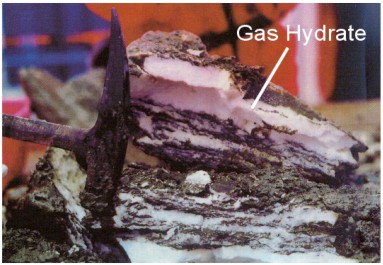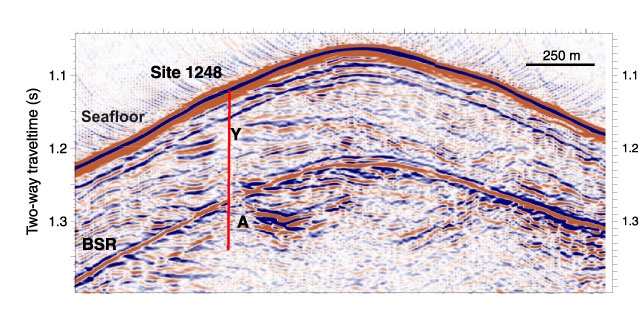Gas hydrates may form wherever water and suitably sized ‘guest’ molecules (e.g. methane, carbon dioxide) exist under suitable (generally) high pressure and low temperature conditions.
Suitable conditions for gas hydrate formation commonly occur during hydrocarbon production operations, where they are a major flow assurance problem. In the natural enviroment, hydrates may be found and in the sediments of the deep sea continental margins, the subsurface of Arctic permafrost regions, and in deep glacial ice.
Gas Hydrates in Hydrocarbon Production Operations
In petroleum exploration and production operations, gas hydrates are a serious economic and safety concern. Low seabed temperatures combined with high fluid pressures promote formation of clathrates in reservoir hydrocarbon-water fluid mixtures. Clathrates can block pipelines, subsea transfer lines, and, in the event of a gas kick during drilling, form in the well, in risers, BOPs (Blow-Out Preventers) and chokelines.
The problems hydrates cause in hydrocarbon production operations, and common methods used to avoid hydrate formation, are summarised on the why are gas hydrates important page
Hydrates in the Natural Environment

In the 1960’s it was recognized that considerable quantities of gas hydrate, namely methane hydrate, occur naturally in sediments of the subsea continental slopes, and in the subsurface of Arctic permafrost regions. Figure-2 shows a sediment sample retrieved from the seafloor which contains layers of gas hydrates.
The gas hydrate stability zone (HSZ) in sediments can be delineated on a temperature versus depth (pressure) profile with respect to the hydrothermal gradient (for subsea gas hydrates), geothermal gradient and clathrate phase boundary, as shown in Figure-3 (for subsea sediments). The position of the hydrate phase boundary is primarily a function of gas composition, but may also be controlled by pore fluid composition (e.g. presence of salts), pore size, and possibly sediment mineralogy. Hydrothermal and geothermal gradients are locality dependent, and can differ markedly with geographical location and tectonic setting. The predominant hydrate-forming gas is methane, with lesser CO2 and hydrogen sulfide (H2S), all of which are generally produced in-situ by microbial breakdown of sedimentary organic matter. In hydrocarbon-rich provinces, clathrates may contain a more deep-seated thermogenic gas component, generally in the form of ethane and propane, which, due to increased thermodynamic stability, can shift the HSZ to considerably shallower depths.

In the absence of core sampling, gas hydrate accumulations in subsea sediments are usually inferred from the appearance on marine seismic profiles of a strong anomalous bottom simulating reflection, or BSR (see Figure-4). BSRs generally mimic seafloor topography at depth, crosscutting existing stratigraphy, and are widely accepted as marking the base of the hydrate stability zone. However, the presence of clathrates within sediments does not necessarily mean a BSR will be present at the base of the HSZ, and the true nature of this feature and its development in relation to clathrate growth still remains the subject of debate. It was originally proposed that BSRs marked the boundary between higher-sonic velocity, hydrate-cemented sediments of the HSZ, and underlying lower-sonic velocity, hydrate-free sediments. However, increasing evidence now points to the seismic velocity contrast as arising from a region of free gas accumulation below the base of clathrate stability.

Clathrate hydrates of atmospheric gases (air) are known to form under the high-pressure and low-temperature conditions of the deep ice sheets of Arctic and Antarctic regions. Clathrates are formed when air pockets trapped in the snow pack are subjected to high overburden pressures following burial to depth. These air hydrates are of great importance to the scientific community in that they can provide vital information on the varying composition of the Earth’s atmosphere over recent glacial-interglacial cycles, greatly improving our understanding of global climate changes. Furthermore, gases originating from air clathrates in ice sheets, if suitably concentrated, could potentially support simple biogenic life forms in subglacial lakes, such as lake Vostok, Antarctica.
Suggested Reading
There are many Journal and Conference publications covering all aspects of gas hydrates available in the literature. Centre for Gas Hydrate Research publication reprints are available as Adobe .pdf files on request. See our publications page for details. We recommend the following books for a good summary of the main issues:
Henriet, J.-P. and Mienert, J. (eds.), Gas Hydrates: Relevance to World Margin Stability and Climatic Change, Geological Society of London Special Publication 137 (1998). Max, D.: Natural Gas Hydrate in Oceanic and Permafrost Environments, Kluwer Academic Publishers, Dordrecht, Netherlands (2000). Sloan, E.D.: Clathrate Hydrates of Natural Gases, Marcel Dekker Inc., New York (1998).
